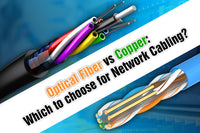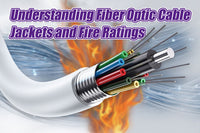Optical fiber cables have deeply influenced telecommunication and how data are transmitted. The optical splitter is a crucial part of the fiber optic passive network system. It is an optical fiber tandem equipment connected to the input fiber, and it splits and conducts the optical signals into multiple output pathways. There are mainly two technologies for manufacturing optical splitters, according to which we can divide the optical splitters into two types: fused biconical taper splitter (FBT splitter) and planar lightwave circuit splitter (PLC splitter). Each type of optical splitter has its advantages and disadvantages. But do you know the differences between FBT and PLC splitters and how to choose a suitable one?
What is the FBT Splitter?
The FBT splitter is a primary optical splitter. Not only does it use cheap and easily available raw materials, but it also holds a manufacturing process simple and threshold-free. An FBT splitter undergoes the following steps during its production:
- Firstly, the optical fibers are stripped of their coating layer to expose the bare glass and are bundled together in a specific configuration. The number of fibers depends on the desired number of outputs.
- Next, the fibers are fused using a high-temperature fusion splicer. Fibers are melted and merged into a single structure in this process.
- The fibers are stretched and twisted to form a particular biconical waveguide structure. The fiber stretching length and torsion angle created during tapering determine the splitting ratio.
- After achieving the desired tapering, the excess input fibers are cut off to ensure correct port configuration. Finally, the splitter is housed in a protective casing to safeguard the fragile fused area.
The uncomplicated flow of production allows this type of optical splitter to be widely applied. But this rough process also makes FBT splitters lack precision, making them suitable primarily for devices with fewer outputs. An FBT splitter over 1×4 will require a combination of several 1×2 structures and an integral package. Steel tube splitter and ABS splitter are two common packaging types for FBT splitter.

Pros and Cons of FBT Splitters
Pros:
- Cost-effective
- Mature technology
- The splitting ratios are customizable
- Asymmetric port configurations are for option
Cons:
- Losses are wavelength-sensitive, and the operating wavelength is restricted
- The failure rate increases substantially for those with port configurations over 1×8
- The insertion loss can be greatly affected by temperature change or other terrible environments.
- Tend to be larger, which can be a drawback in space-limited installations
- Poor uniformity in light splitting can affect the transmission distance
What is the PLC Splitter?
The PLC splitter takes an optical chip containing a lightwave circuit as the core component. The input fiber on the fiber optic link transmits light energy to the chip through an optical array coupled to one end of the chip, and the waveguide on the chip plays a role in splitting the optical signals and conducting them to the output fibers through another optical array coupled to the other end of the chip. The introduction of semiconductor chip technology contributes to reducing the size of optical splitters. Moreover, this sophisticated technology has effectively improved the division capacity of such splitters, making the splitting more accurate and even. But this also means that the fabrication process of the PLC optical splitter is more complicated. In terms of packaging way, there are many types of PLC splitters, for example, bare splitter, mini PLC splitter with steel tube or module design, ABS PLC splitter packaged in a plastic box, LGX PLC splitter or cassette splitter packaged in a metal box, rack-mounted PLC splitter designed for 19-inch rack, etc. PLC splitters are preferable in FTTH deployments.

Pros and Cons of PLC Splitters
Pros:
- Can offer various operating wavelengths for various optical transmission technologies
- High uniformity, ensuring consistent signal distribution across output ports.
- Compact size, suitable for installations with tight space
- Accurate, reliable, and stable split thatis not subject to fail
Cons:
- Complex manufacturing process and high technical barrier
- Price disadvantage, especially for low-channel-count PLC splitters
- Limited customization options for port configurations and splitting ratios.
7 Primary Differences Between PLC and FBT Splitters
Operating Wavelengths
The operating wavelengths supported by the FBT splitter are limited to the following four values but allow a bit of fluctuation: 850 ± 40 nm (custom), 1310 ± 40 nm, 1490 ± 10 nm, and 1550 ± 40 nm. As for the PLC fiber splitter, since the insertion loss remains relatively stable under different wavelengths, its typical operating wavelength spans from 1260 to 1650 nm, encompassing almost all wavelengths required in optical equipment and passive optical network (PON) applications.
Input/Output
The FBT optical splitter supports a maximum split configuration of 32 channels, offering standard models like 1×2, 2×2, 1×16, alongside specific models like 1×3 and 1×7. In contrast, the PLC splitter can divide light energy into up to 64 portions but only offers standard models such as 1×8, 1×32, 2×64, etc.
Splitting Ratios
FBT splitters offer flexibility in splitting ratios, especially in scenarios requiring unequal signal distribution. These splitters allow for adjustable splitting ratios depending on the application's needs, such as 40:60, 30:70, or even 10:90.
In contrast, PLC splitters generally split light equally across all ports, which means that the splitting ratio of a regular 1×2 PLC splitter is 50:50, and a regular 1×4 PLC splitter owns a splitting ratio of 25:25:25:25. In field applications, people sometimes use multiple splitters in cascade to customize the splitting ratio.

Failure Rate
FBT splitters with more branches bear a greater risk of failure. Only FBT splitters 1×4 and below are proven to be trustworthy so far. Moreover, making through fusing and tapering optical fibers, the FBT splitters are more prone to inconsistencies and defects. Consequently, they exhibit limited resistance to mechanical shock and vibration. On the other hand, PLC splitters have a lower failure rate and offer higher environmental and mechanical stability. They also guarantee better spectral uniformity thanks to the highly consistent manufacturing.
Working Temperature
PLC splitters are friendly to extreme weather conditions, withstanding temperatures ranging from -40℃ to 85℃. But FBT splitters are only applicable for temperatures ranging from -5℃ to 75℃ due to their sensitivity to temperature and poor resistance to thermal expansion and contraction.
Size
High-channel-count FBT splitters require the connection of multiple fiber fusion structures. Besides, the fibers should maintain a certain bending diameter. Therefore, they occupy more physical space and are typically utilized in scenarios where space is not a concern. PLC splitters feature a smaller package size, making them suitable for space-limited applications such as fiber optic patch panels and network terminals.
Cost
As for low-channel devices, FBT splitters are cheaper than PLC splitters. However, as the port configurations increase, this price advantage diminishes. It is because, in the production of high-channel equipment, the qualified rate of finished products for FBT splitter decreases, while there is no significant increase in the production cost of PLC splitter. Thus, PLC splitters may be the more cost-effective ones for high-channel devices.
PLC and FBT Splitter in PON Network
With the rapid spread of FTTX networks, FBT and PLC optical splitters have found their place in PON applications, such as telecommunication, fiber optic local area networks, cable television, optical sensors, measuring instruments, etc. FBT splitters are economical for scenarios with few branches, such as independent data transmission channels and television video networks. While in scenarios that require a wide wavelength range and own plenty of users, such as network convergence systems and FTTH, PLC splitters are more practical. They are also better for broadband transmission or fiber optic communication systems.
PLC splitters are widely used in passive optical networks to connect service provider endpoints and terminal demarcation devices in front of customer premises wiring. Whether in centralized distribution or distributed access architectures prevalent in fiber-to-the-home (FTTH) deployments, PLC splitters can meet all the needs.
Conclusion
In summary, PLC splitters surpass FBT splitters in terms of benefits. Although FBT splitters may be appropriate for small passive optical LANs, rural FTTX deployments, and specific asymmetric split ratio applications, PLC splitters, known for their superior performance, are better suited for broader fields. You could consider all the factors like wavelength compatibility, splitting ratio, operating environment, available space, and budget before making up your mind.
FAQ
How does a PLC splitter function?
The light passes through the input fiber array of the PLC splitter and enters the planar lightwave circuit chip. The optical waveguide on the semiconductor chip divides the light into two or more independent signals and guides them to the output fiber array. Finally, the signals are output from different channels.
Which splitter is better for long distances?
The insertion loss of each output end of an FBT splitter varies greatly. The nominal max uniformity difference of a 1×4 FBT splitter of an equal split is about 1.5 dB, let alone the larger splitters. The poor uniformity affects its overall transmission distance. There is no significant difference in insertion loss at each output terminal of the PLC splitter, making it better for long-distance applications.
Where can PLC splitters be applied?
In FTTx network architectures, PLC splitters provide optical communications to residential and commercial areas.
In data centers, PLC splitters distribute optical signals to multiple endpoints.
In internal wiring, PLC splitters connect multiple devices requiring Internet access.
For more information on this topic, you can keep up on our blogs. While VCELINK offers general and basic information for our customers and other visitors to the website, it’s not professional advice.



Hi everyone,
i’m looking for a splitter, that can operate in lower wavelength (RGB ~ 400nm – 800 nm).
the PLC Splitter are designed for optical transmission to operate in higher wavelength, can they also split and pass RGB lights?
thank you for advise.
Best regards,
Lotfi